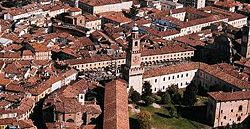Castles of Lomellina is an itinerary that takes place through the Lombardy.
Introduction
A journey through the history of Lomellina, between water and land.
How to get
By car
To reach Vigevano:
- From Milan: Tangenziale Ovest and follow the state road 494
- From Turin: leave the A4 motorway at Novara, take the East exit
- From Genoa: A7 Milan-Genoa motorway: exit at Gropello-Pavia sud
Stages
- 1 [link not working]Vigevano Castle - It was between the end of the 13th and the beginning of the 14th century, the seat and stately home of the Visconti. Luchino Visconti, mayor of Vigevano in 1319 and 1337, he included the village in his plan of territorial domination, deciding to make it a defensive stronghold inserted in the territorial chessboard of the castles located along the Adda and Ticino to defend the Duchy of Milan. In 1341 he built a defense fortress located at a certain distance from the castle, on the eastern edge of the village which was now expanding outside the original perimeter. In 1447, at the end of the Visconti dominion, the same population of Vigevano conquered municipal freedom and destroyed the external fortress. Galeazzo Maria Sforza in 1466, as soon as he succeeded his father Francesco, ordered new interventions that definitively transform the keep into a ducal palace and allowed the construction of houses in the external moat. In 1472 the new Duke intervenes on two ancient buildings, placed along the southern wall of the ancient village and used as a stable, raising them and modifying the ground floor with the insertion of a double colonnade with cross vaults and new windows. In 1475 he created the bridge with a loggia, located south of the keep. With Ludovico il Moro the Sforza project is implemented in interventions of significant proportions and qualities, completing the process of transforming the castle into a dynastic residence. The keep is enlarged on the east side with the creation of a hanging garden enclosed by two porticoed buildings designed by Bramante and open to the east. Of the Bramante complex today, after the collapse of the loggia leaning against the covered road and the emptying of the garden with the lowering to its current level, only the south building called the "ladies' lodge" remains.
- 2 Mortara —
- 3 Castello d'Agogna —
- 4 Robbio Castle —
- 5 Cozzo Castle —
- 6 Breme —

Sartirana Lomellina Castle
- 7 Sartirana Lomellina Castle - The Visconteo Castle was built at the end of the 1300s at the behest of Gian Galeazzo Visconti and on a project by Captain Jacopo dal Verme. Towards the end of the 15th century the Sforza family raised a floor and strengthened the defenses of the manor. In the 16th century the castle was transformed into a comfortable residence by the Gattinara family and took on its present appearance. Sartirana and its castle then passed to the Spaniards with Mercurino Arborio until his death in 1530. The manor belonged to the Arborio dynasty until 1934, and then to the Duke Amedeo di Savoia-Aosta. The layout is quadrilateral, with a perimeter moat, an internal courtyard and four corner towers. The privately owned building currently houses the "Lomellina Study and Documentation Center" and the "Sartirana Arte Foundation".
- 8 Frascarolo Castle —
- 9 Mede Castle —
- 10 Lomello Castle —
- 11 Valeggio Castle —

Scaldasole Castle
- 12 Scaldasole Castle - The original nucleus of the castle was built between the 10th and 12th centuries and was a fief of the Campeggi family. Between 1334 and 1404 it passed to the Folperti family who commissioned the construction on the south side of the original castle, of the ricetto, a vast rectangular fortified courtyard capable of gathering the entire population of the town in case of need. Subsequently, the Marquises Malaspina, new feudal lords, embellished the castle with a portico and a loggia and had some rooms frescoed. It was this building complex, with its seven medieval towers, Renaissance vaults and fireplaces, that over time hosted some illustrious personalities including in 1491 Isabella of Aragon, daughter of Alfonso Duke of Calabria and betrothed of Gian Galeazzo Sforza, Duke of Milan , in 1497 the emperor Maximilian I of Habsburg and in 1533 Charles V of Habsburg. Between the fifteenth and seventeenth centuries the castle was the subject of countless changes of ownership, including: Filippo Maria Visconti. In 1457 it came to Francesco Pico della Mirandola Count of Concordia and in 1461, by succession, to his son-in-law Giacomo Malaspina, Marquis of Fosdinovo. In 1577 it was sold to Count Rinaldo Tettoni, who sold it to Cardinal Tolomeo Gallio di Como in 1582 whose heirs, the Gallio Trivulzio dukes of Alvito, sold the local properties to their level manager Carlo Brielli in 1799 who, three years later, he gave it in perpetual investiture to the noble Giovanni Antonio Strada di Garlasco, to whose descendants it still belongs.
- 13 Dorno —
- 14 Gropello Cairoli Castle —
- 15 Garlasco Castle —
- 16 Gambolò Castle —

